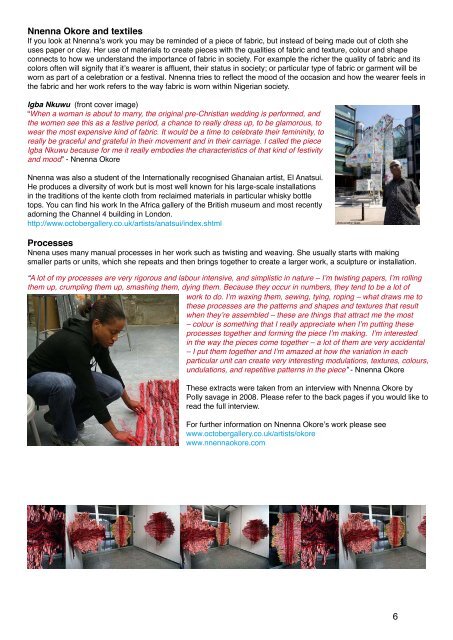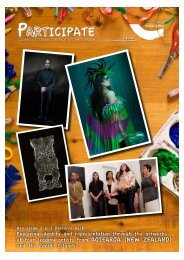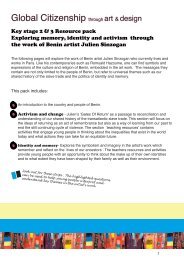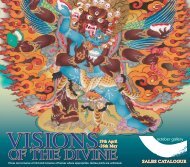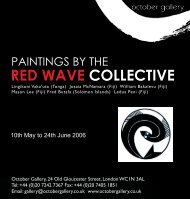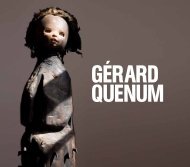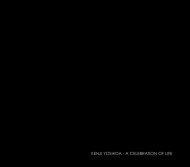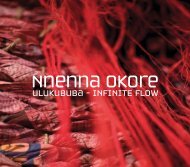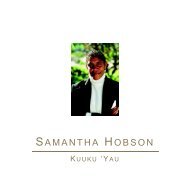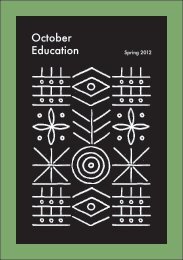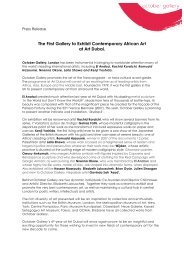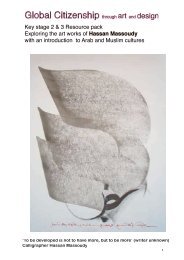You also want an ePaper? Increase the reach of your titles
YUMPU automatically turns print PDFs into web optimized ePapers that Google loves.
<strong>Nnenna</strong> <strong>Okore</strong> and textiles<br />
If you look at <strong>Nnenna</strong>’s work you may be reminded of a piece of fabric, but instead of being made out of cloth she<br />
uses paper or clay. Her use of materials to create pieces with the qualities of fabric and texture, colour and shape<br />
connects to how we understand the importance of fabric in society. For example the richer the quality of fabric and its<br />
colors often will signify that it’s wearer is affluent, their status in society; or particular type of fabric or garment will be<br />
worn as part of a celebration or a festival. <strong>Nnenna</strong> tries to reflect the mood of the occasion and how the wearer feels in<br />
the fabric and her work refers to the way fabric is worn within Nigerian society.<br />
Igba Nkuwu (front cover image)<br />
“When a woman is about to marry, the original pre-Christian wedding is performed, and<br />
the women see this as a festive period, a chance to really dress up, to be glamorous, to<br />
wear the most expensive kind of fabric. It would be a time to celebrate their femininity, to<br />
really be graceful and grateful in their movement and in their carriage. I called the piece<br />
Igba Nkuwu because for me it really embodies the characteristics of that kind of festivity<br />
and mood” - <strong>Nnenna</strong> <strong>Okore</strong><br />
<strong>Nnenna</strong> was also a student of the Internationally recognised Ghanaian artist, El Anatsui.<br />
He produces a diversity of work but is most well known for his large-scale installations<br />
in the traditions of the kente cloth from reclaimed materials in particular whisky bottle<br />
tops. You can find his work In the Africa gallery of the British museum and most recently<br />
adorning the Channel 4 building in London.<br />
http://www.octobergallery.co.uk/artists/anatsui/index.shtml<br />
Processes<br />
Nnena uses many manual processes in her work such as twisting and weaving. She usually starts with making<br />
smaller parts or units, which she repeats and then brings together to create a larger work, a sculpture or installation.<br />
“A lot of my processes are very rigorous and labour intensive, and simplistic in nature – I’m twisting papers, I’m rolling<br />
them up, crumpling them up, smashing them, dying them. Because they occur in numbers, they tend to be a lot of<br />
work to do. I’m waxing them, sewing, tying, roping – what draws me to<br />
these processes are the patterns and shapes and textures that result<br />
when they’re assembled – these are things that attract me the most<br />
– colour is something that I really appreciate when I’m putting these<br />
processes together and forming the piece I’m making. I’m interested<br />
in the way the pieces come together – a lot of them are very accidental<br />
– I put them together and I’m amazed at how the variation in each<br />
particular unit can create very interesting modulations, textures, colours,<br />
undulations, and repetitive patterns in the piece” - <strong>Nnenna</strong> <strong>Okore</strong><br />
These extracts were taken from an interview with <strong>Nnenna</strong> <strong>Okore</strong> by<br />
Polly savage in 2008. Please refer to the back pages if you would like to<br />
read the full interview.<br />
For further information on <strong>Nnenna</strong> <strong>Okore</strong>’s work please see<br />
www.octobergallery.co.uk/artists/okore<br />
www.nnennaokore.com<br />
6


